The market’s sharp rise last week affected all our ETF Model Portfolios in a positive way. While they did not move up as fast as the S&P 500 did, they also did not lose ground as quickly, when the markets declined 7 out of 8 weeks.
That has been my theme all along. When the major indexes were on a tear earlier this year, the S&P 500 raced ahead in terms of YTD performance by over 3% compared to some of our models. However, during the recent market decline, it trailed by over 3%; now it has again pulled ahead by a slight margin.
Unless, you are a financial rollercoaster lover, you’re better off keeping a steady hand when it comes to the fluctuations of your portfolio – at least that is my preference.
Take a look at the changes of the past week:
1. ETF Trend Tracking Model Portfolio
This is the portfolio allocation I predominantly use in my advisor practice. Given current market conditions, and an ever growing number of global hotspots, I like the concept of having a solid core holding in PRPFX, although with the recent slide, it slipped as well but managed to remain far more stable than the S&P 500 index.
Around this fund, I have added what I call boost components consisting of ETFs that can produce higher returns than my core holding, at least during bullish periods. When a market pullback occurs, the core holding should add an element of stability.
This is exactly what happened early in March 11, when the double natural disasters struck Japan. While the S&P 500 lost all of its YTD gains, and dropped into negative territory, this portfolio stayed positive.
Nevertheless, as you know from my writings, anything I invest in involves the use of trailing sell stops, which are shown and tracked on the upper right of the table.
Last week, this portfolio was up YTD +4.72% vs. +5.46% as of today.
2. Conservative ETF Growth Portfolio
This portfolio, as are the following ones, would be typical of what is being used in the buy-and-hold community, as you can see by the 40% allocation to various bond ETFs. If you are conservative, this simple combination could work for you, but I still recommend the use of the trailing sell stops during these uncertain times.
Last week, this portfolio was up YTD +3.33% vs. +4.41% as of today.
3. Aggressive ETF Growth Portfolio
What makes this one aggressive is the small 15% allocation to bonds. This portfolio was leading the bunch on a YTD basis, but with the recent correction, it came off its high very quickly but managed to crawl back into the #1 spot.
If you have an aggressive streak in your personality, you could consider this one. If you use my recommended sell stop discipline, you know exactly ahead of time what your downside risk will be.
Last week, this portfolio was up YTD +5.25% vs. +5.68% as of today.
4. Moderate ETF Growth Portfolio
I call this one moderate growth, because of the higher allocation to various bond ETFs (26%) than in the aggressive set up above. It is also more diversfied domestically, but as the YTD return shows, that does not seem to matter much as it continues to trail my Trend Tracking Portfolio by a small margin.
Last week, this portfolio was up YTD +4.21% vs. +4.38% as of today.
5. ETF Income Portfolio
This is as simple as it gets, but due to a reduction of half of its holdings, this portfolio has slipped into the #5 spot. During the recent sell-off, it dropped in value quickly due to no offsetting bond positions and now shows only a 50% invested balance. Be sure to use a 7% sell stop on the remainder of these holdings.
Last week, this portfolio was up YTD +4.09% vs. +4.77% as of today.
6. The Ivy ETF Portfolio
If you missed the recent post about the Ivy portfolio, you can read it here.
This is a simple 5-asset class portfolio with each individual component being bought when it crosses its respective trendline to the upside. Each component is being sold once it crosses its trend lines to the downside again, according to the author’s rules.
I have made 3 adjustments:
1. I apply a 39-week Simple Moving Average (SMA) to generate the Buys, while the authors use a 45-week SMA.
2. As mentioned in the blog post, I prefer using my trailing sell stop discipline for my exit strategy.
3. Personally. I favor using BND (as opposed to IEF) as my bond component, since it has shown more stabilty in the past.
This portfolio was also affected by the sale of DBC. I will re-enter this position once it has taken out its old high of 31.92 to be sure that any rebound is not just another headfake.
Last week, the Ivy portfolio was up YTD +4.49% vs. +5.43% as of today.
To repeat, the key to selecting a portfolio from the above list is not just performance. Personally, I’d rather lag a little on the upside but have some assurance that I will also lag when the downside comes into play.
This will help you to sidestep whipsaw signals on occasion, which are caused by temporary market pullbacks followed by a subsequent resumption of the previous up trend.
I will update these portfolios every Wednesday and inform you via email that the updated versions have been posted.
Quick Reference:
Contact Ulli
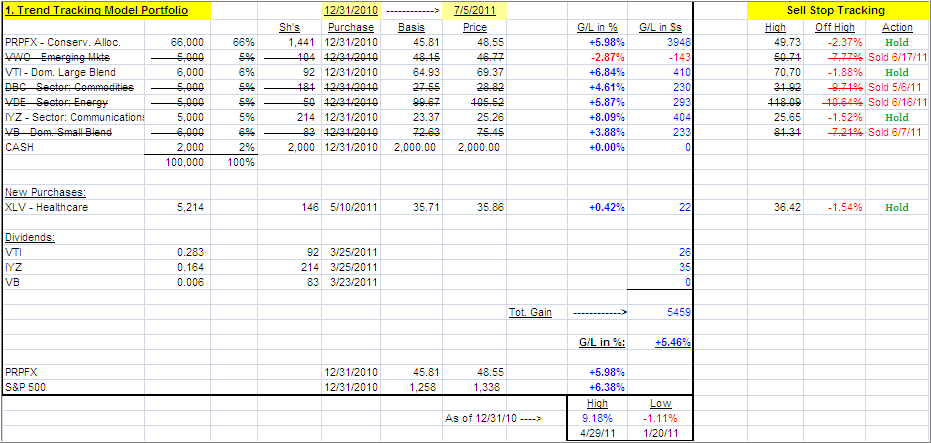
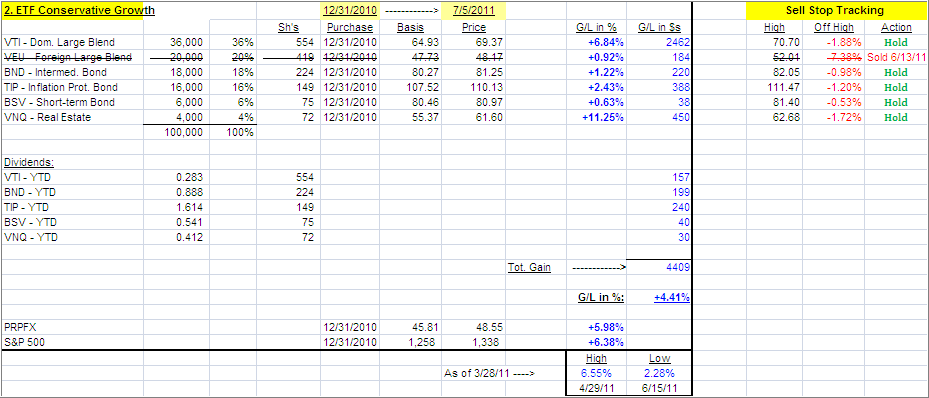
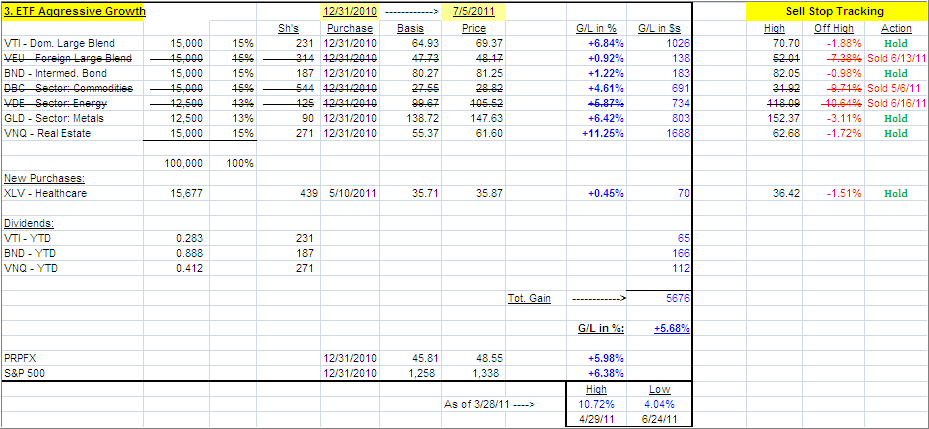
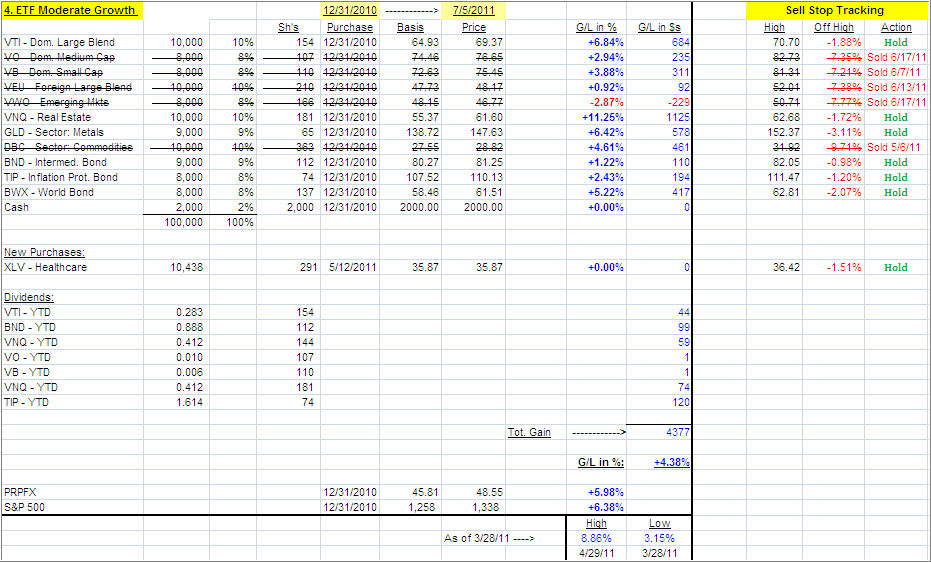
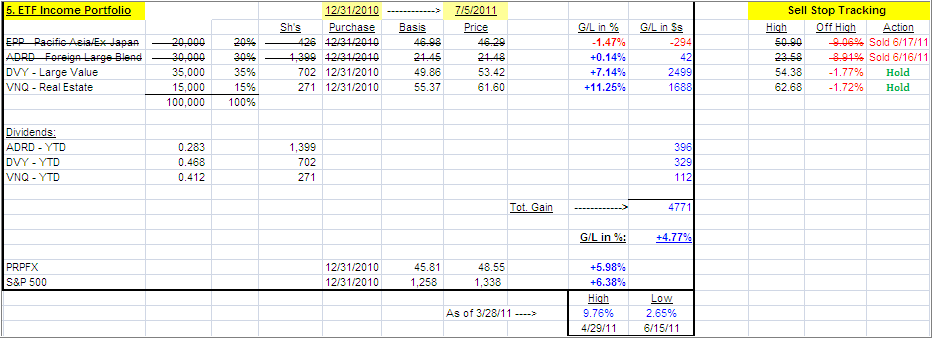
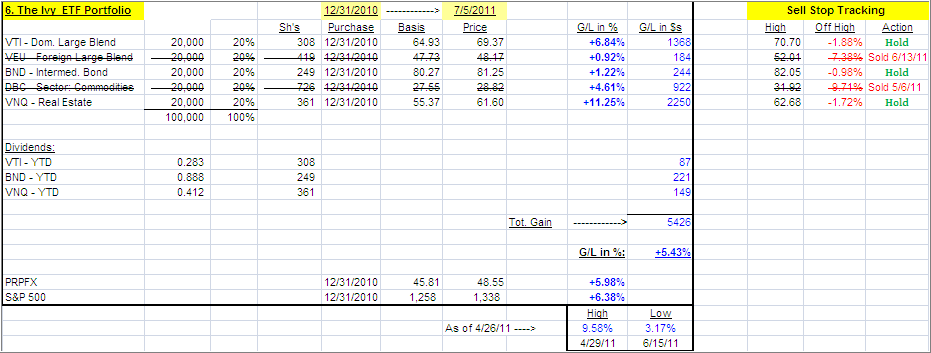
Comments 2
Hello, thank you for your website, which I continue to study and monitor — especially your six model portfolios. Question: with all the recent “sold” positions in your model portfolios — where are you putting those proceeds from the sold funds/ETFs? Are you parking it in cash, or simply shrinking the entire portfolio to reflect a much smaller pot of invested monies? It’s not clear to me how you’re figuring YTD gains and how/when you will be invested those monies again.
Could you talk about this a little?
Thank you.
James,
Yes, the invested amount of money is simply reduced and stays in momey market until other opportunities present themselves. That means greatly improved momentum numbers.
Ulli…